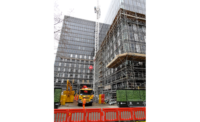With its workforce now peaking at around 30,000, the U.K.'s London-Birmingham 140-mile HS2 high speed railroad is shifting into the fit-out stage with more than $6 billion of track and system work being readied for procurement.
Railroad system installation on the southern section is expected to start in 2026-2027, as heavy civil engineering work winds down. All work on the planned 51-mile northern route was canceled in October and the government has started spending some of the money saved by fixing potholes in London roads.
“The transition in our focus towards railway systems represents another significant milestone and will edge us ever closer towards bringing this transformational project to life," said Jon Thompson, the executive chair of the project owner HS2 Ltd.
The country's longest railroad viaduct, the 2.1-mile Colne Valley crossing, is about one-third built with work on some 500 bridges at various stages. A total of 9.3 miles of elevated structures are to be completed, as well as 65 miles of twin tunnels.
Under the Chiltern Hills, around 25 miles from London, two tunnel boring machines have completed 90% of the project’s longest drives, of 10 miles. As HS2's first machines in the field, they were launched in spring 2021.
 TBM Florence is one of two TBMs that have been boring under the Chiltern Hills. Photo courtesy of HS2 Ltd.
TBM Florence is one of two TBMs that have been boring under the Chiltern Hills. Photo courtesy of HS2 Ltd.Under Birmingham, the first of two TBMs is working on the 3.6-mile Bromford Tunnel, while some 25 miles toward London, a single machine has completed both drives of the 1-mile Long Itchington Wood section.
Nearer London and working from the west, two TBMs have driven more than a third of the 8.5-mile Northolt tunnels between West Ruislip and Old Oak Common, where a major HS2 station is being developed. Two more machines are due for launching soon to drive the tunnels' eastern bores.
While all these machines have definite goals, the 2,800-ft-long logistics tunnel being driven by the solitary TBM "Ellie" towards Old Oak Common has an uncertain fate.
It is being built to carry precast lining segments and extract spoil from the 4.6-mile twin tunnel into HS2's London terminal at Euston. The two machines meant to drive those tunnels are due on site in 2024.
But when Prime Minister Rishi Sunak canceled HS2's northern stretch, he also declared that the Euston development could only go ahead with private financing. Until a new plan for Euston emerges, HS2 will remain just out of reach of its southern destination.
Meanwhile, the government has started committing some of the billions saved by canceling HS2's Birmingham-Manchester section. In allocating $300 million to filling holes in London's roads, transportation secretary Mark Harper said the government was redirecting "HS2 funding to make the right long-term decisions for a brighter future."




Post a comment to this article
Report Abusive Comment